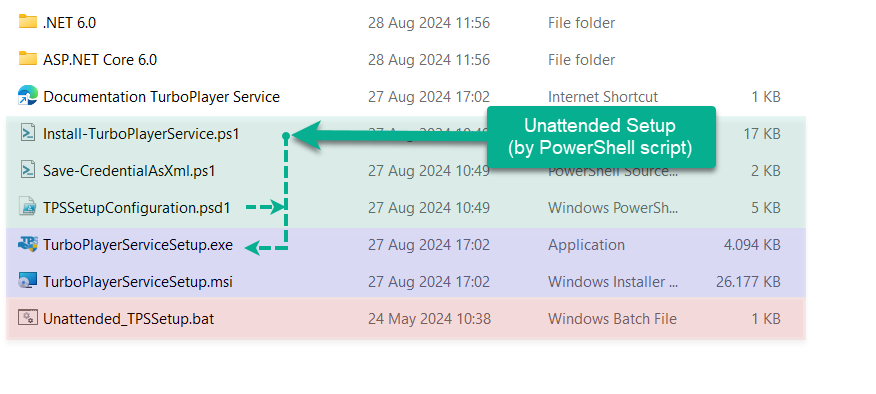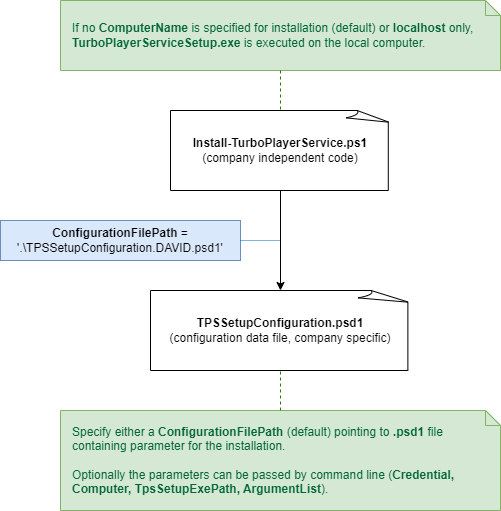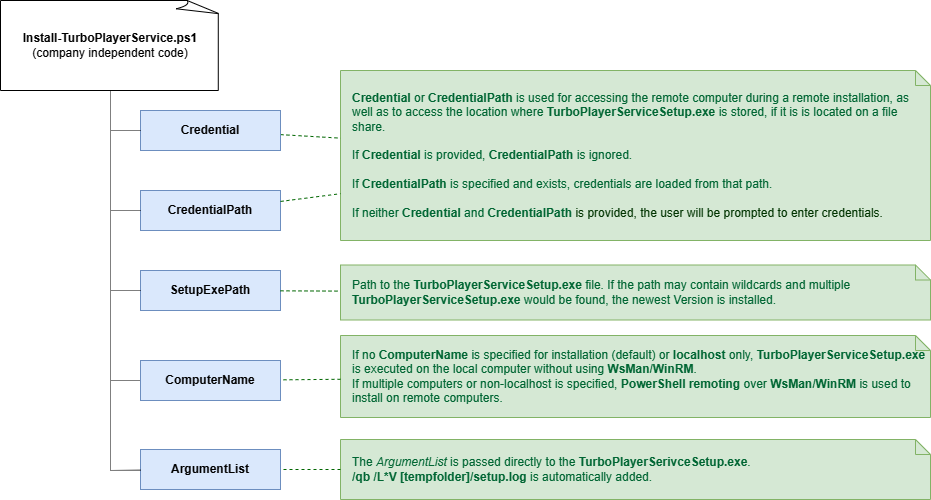Unattended TPS Setup (by PowerShell Script)
This page describes the installation of TurboPlayer Service by using a PowerShell script.
Usage scenario
First, the unattended installation using PowerShell is ideal for installing on a local computer when all configuration parameters are known in advance.
Additionally, the PowerShell installation supports wildcards for locating and installing the latest version of the TurboPlayer Service Setup. This feature is particularly useful in automated testing and CI/CD (Continuous Integration and Continuous Delivery/Deployment) scenarios. When the TurboPlayer Service Setup folder is added as a sub-folder, the scripts automatically search for the newest version and proceed with the installation.
Installation Procedure
Setup Folder
The TurboPlayer Service setup consists of TurboPlayerServiceSetup.exe, TurboPlayerServiceSetup.msi, the .Net 6.0 Runtimes (x86, x64) and the ASP .NET Core 6.0 Runtimes (x86, x64). Additionally, it includes Install-TurboPlayerService.ps1 a PowerShell installation script, TPSSetupConfiguration.psd1 for the configuration of the installation and Save-CredentialAsXml.ps1 to prompt for credentials and store them encrypted in an Credential.xml file.
Copy the PowerShell scripts
Install-TurboPlayerService.ps1,TPSSetupConfiguration.psd1into a local directoryCopy the complete installation folder (
Setup) to a file share

TurboPlayer Service Setup folder
Installation with PowerShell Scripts
Open the file
TPSSetupConfiguration.psd1with your favorite text editor (or Notepad)
The configuration file contains configuration properties
Property name | Explanation | Example | Type | Allowed values | Default value |
|---|---|---|---|---|---|
ComputerName | Specify the list of computers where TurboPlayer service should be installed on. Leave ComputerName empty to install TurboPlayer service on the local computer. | ‘', 'VM-TPS-04’ | comma-separated list of strings | The NETBIOS name, IP address, or fully qualified domain name of one or more computers in a comma-separated list. | |
CredentialPath | CredentialPath contains the path to an xml file which contains the credentials for accessing the remote computer and the file share where | '.\Credential.xml' | string | a filename | |
SetupExePath | SetupExePath specifies the path where | '\\fileserver1\digasoft\SW_ARCHIV\TurboPlayerService\Software\*\Setup\TurboPlayerServiceSetup.exe' | string | file path including wild cards ‘*' and '?’ | |
SetupArgumentList | SetupArgumentList contains the properties which are passed the as argument list to the Setup program. |
@{
<#
TPSSetupConfiguration.DAVID.psd1
Configuration file for Install-TurboPlayerService.ps1
- Version: 1.0.0.1
#>
# Specify the list of computers where TurboPlayer service should be installed on.
# Leave ComputerName empty to install TurboPlayer service on the local computer.
# Remove the comment ('#') to install parallel on multiple computers.
# If a computer other than an empty string is specified, PowerShell remoting with WsMan/WinRM is used.
# Remote computer must be reachable via WsMan/WinRM. In this case CredentialPath is used for accessing the remote computer.
ComputerName = '' #, 'VM-TPS-04',
# CredentialPath contains the path to an xml file which contains the credentials for accessing the remote computer and
# the file share where TurboPlayerServiceSetup.exe is located (SetupExePath).
# The '.\Credential.xml' file specified CredentialPath can be created with the Save-CredentialAsXml.ps1 script.
# If CredentialPath is specified but the file does not exist, the script prompts for credentials with Get-Credential.
# The Credentials file contains the password as secure string.
# This means credentials are only valid if they are encoded with the current user and the current computer
CredentialPath = '' # '.\Credential.xml'
# SetupExePath specifies the path where TurboPlayerServiceSetup.exe is located.
# The path may contain wildcards e.g. *, to find unknown or not existing folders with new TurboPlayerServiceSetup.exe version.
# If multiple TurboPlayerServiceSetup.exe are found, the highest version is installed.
#SetupExePath = '\\fileserver1\digasoft\SW_ARCHIV\TurboPlayerService\Software\*\Setup\TurboPlayerServiceSetup.exe'
SetupExePath = '.\TurboPlayerServiceSetup.exe'
# Set the parameter for the TurboPlayer Service setup
SetupArgumentList = @{
...
}
}The PowerShell cmdlet Install-TurboPlayerService.ps1 can be executed with a configuration file and a credential file
Installation with a configuration file
When using a configuration file for the installation specify the parameter set ByConfigurationFilePath e.g.,
.\Install-TurboPlayerService.ps1 -ByConfigurationFile "C:\Temp\TPSSetupConfiguration.psd1"
or by specifying the parameter via the command line.


